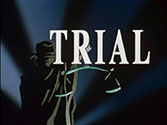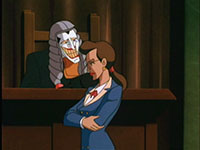|
||
|
| Credits | Cast | |
Story by Paul Dini & Bruce Timm Teleplay by Paul Dini Directed by Dan Riba Music by Harvey R. Cohen Animation by Dong Yang |
Kevin Conroy as Bruce Wayne Bob Hastings as Commissioner Gordon Liane Schirmer as Renee Montoya George Dzundza as Scarface/Ventriloquist Mark Hamill as The Joker |
Aron Kincaid as Killer Croc Roddy McDowall as Jervis Tetch Richard Moll as Two Face Arleen Sorkin as Harley Quinn Stephanie Zimbalist as Janet van Doren |
|
Of course, the concept of the episode—both the idea that Batman should be put on trial by his Rogue's Gallery, and that we should get the Rogues all mixed together in a flavorful pudding—is irresistable. Surely Sondheimian mathematics applies to villainy?
Well, the law of diminishing returns, for one thing. Though Joker and Harley may still feature in a stand-out sketch, all the others just get in each other's way. Oh, they all have their little moments—Two Face acting as prosecutor or baiting with Ivy, Hatter complaining about Batman's interference, Scarface bringing order to the court—but those are moments that cry out for a fuller exploration and development. And poor Croc and Scarecrow get shunted aside as muscle. More subtly, in mixing the baddies the episode forgets how each story takes its cue from the villain. Compare the atmospheric darkness of "On Leather Wings" with the dank vapors of "Vendetta"; the gleaming chill of "Deep Freeze" with the poisonous greenery of "House and Garden"; or the pop-eyed mirth of any Joker episode with the silky seductiveness of a Catwoman. In BTAS, style and tone illustrate psychology, the solipsistic nature of madness. Each of the villains tries to recreate the world according to his or her own warped ideals or desires, and the best of the episodes illustrate that fact—and hint at the horrible results—by giving us reality from inside the bad guy's head. But in "Trial" the different perspectives and sensibilities cancel each other out or fracture in inconsistent directions. Even the plot device of the trial palls. At the end, the Rogues acquit Batman, having discovered that they are responsible for screwing up their own lives. Those viewers conversant with "Two Face," "Pretty Poison," "Mad as a Hatter," etc., may be forgiven for finding this conclusion unsurprising. But even as an exercise in action the story is shapeless and devoid of tension, being given overmuch to scenes of forensic examination. It feels too much like a compilation episode, except they forgot to insert the old footage that is the only excuse for the framing device. At the end you're left wondering: Was this a story that really needed to be told, given that we have seen its particulars developed and illustrated elsewhere? |
|
|
|
Related Episodes |
What Others Are Saying ... |
| Back to Time Out of Joint |
Forward to Two Face |


